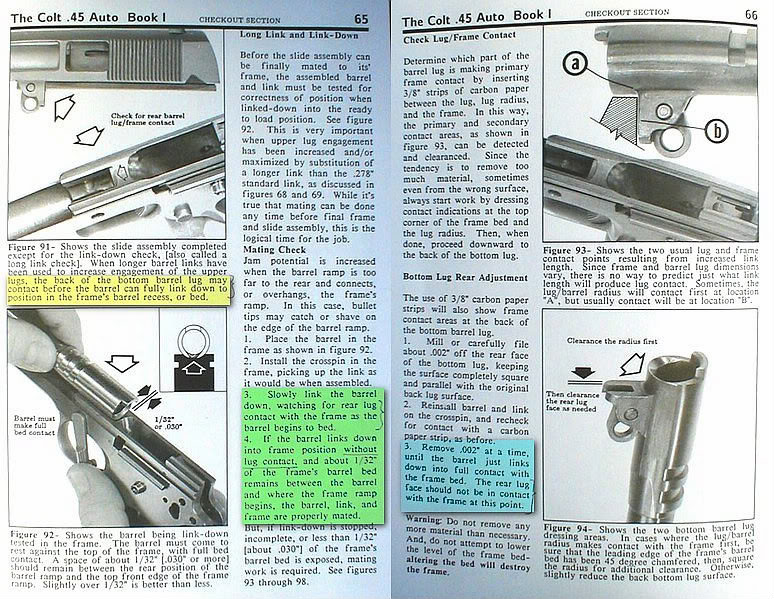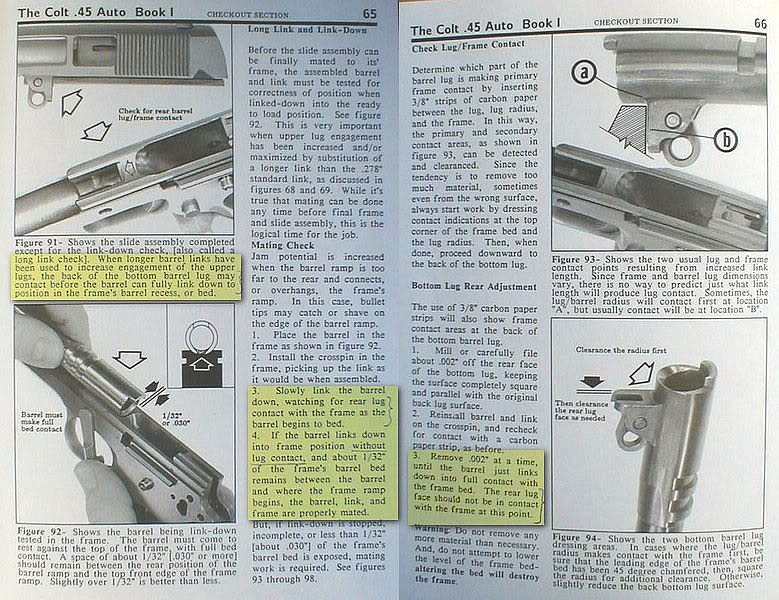
Santa brought me both volumes of Jerry Kuhnhausen's shop manuals on the 1911. Pages 65 & 66 in Vol I (1990 printing) lead me to belive he calls for the barrels lower lugs to never contact the VIS at any time during the linkdown process. Linkdown is to be stopped by contact with the barrel bed in the frame without any VIS contact. They're highlighted here:

Yet in Vol II, Kuhnhausen includes the Schuemann timing tests which (along with the JMB patent and 1911 Tuner's teachings) caution that the lower lugs must make VIS contact - and do so prior to contacting anything else (the barrel bed).
What's the problem with all this?
Mayhap he changed his mind between Vols 1 & 2?
Niemis24s, I got both these volumes for Christmas too, and I found another error, probably just a typo, but an error none the less. In Volume II, on page 176, fig. 163, it shows the mag catch notch as having a dimension of .299" from the bottom of the tube. I believe this dimension should be 2.99" (midspec) as is indicated elsewhere.
Forsooth! A fourth possibility, as Vol II's date is 1997 - seven years after the last Vol I date (at least the ones I have).
Are these images any better?
PICTURE 404

Well, a little bit different but still pretty bad! Rats!!
I believe the J.K. manuals are by far the best for reference, there are however, many inaccuracies and misconceptions as to the function and tuning of the 1911 contained in these manuals.
When discussing an understanding I had with a local known pistolsmith and I told of learning what I knew on that subject from J.K. he ever so nicely said you'll have to get and read many more references and come to your own conclusion as so many things are written as fact and in fact are opinions.
It should also be understood that J.K. is an author and a good one. I have yet to hear of or seen a J.K. built or tuned 1911! Wil Schuemann who gave J.K. many references and information for these manuals, will flat out say that J.K. was not a gunsmith.
Quote:
I believe the J.K. manuals are by far the best for reference, there are
however, many inaccuracies and misconceptions as to the function and tuning of
the 1911 contained in these manuals.
Thanks. That makes me feel a lot better about my reading comprehension. Guess I'll stick with this description of what part of the barrel hits what part of the frame:

It's from page 3 of some crusty old document - JMB's patent.
And my thanks again to Pdangeruss for the patent. Very handy to have.
Not only was Kuhnhausen a gunsmith, but a very good one. The reason that you don't see any guns built or tuned by Kuhnhausen is because he kept it low-key instead of outing himself as a Purveyor of Bling, and stuck with general repair. If you've ever sent a gun away for warranty work... you may have had a "Kuhnhausen Gun" and never knew it.
That said... being a competent or even an extraordinary smith doesn't mean that any given design is completely understood in its design and function. There's no way that a general gunsmith could possibly know all that there is to know about every gun design. That pretty much requires being a specialist... much like a medical doctor.
You don't expect your family general practitioner to know all the ins and outs of oddball skin diseases or eye problems, do you? Of course not.
Kuhnhausen's main area of expertise was revolvers and bolt-action rifles... but he still didn't return any that he built or reworked emblazoned with JK inside French borders. I never met him, but those who I've spoken with who have describe him as a quiet, unassuming and humble man who would more likely be mistaken for Mr. Rogers than a gun wrench.
I have four of Jerry's books the two 1911 manuals, the S&W revolver, and the .30 Caliber Gas Operated Service Rifle manuals and would replace them immediately if lost for any reason.
While these are stunning with the concentration of information, there are many inaccuracies that are surprising. Not typos just plan inaccuracies, that "1911 Tuner" has pointed out as well, over the years of his help and understanding of the 1911 and it's function.
Quote:
While these are stunning with the concentration of information, there are
many inaccuracies that are surprising
Well... not really, considering that those manuals were basically compiled from shop notes that spanned about 30 years of work. As a rule, practitioners of the trade learn as they go... and evolve as they learn. Kuhnhausen's discrepancies are more likely the fault of hasty proofreading and/or editing than anything else. A good example is the "Balanced Thrust Vector" theory that's been altered in the later editions. It's still there... but it's been amended to a more correct explanation of what goes on during the firing phase... that includes touching on the bullet's forward drag in the barrel.
For those who joined late... the "Balanced Thrust Vector" theory can be viewed on the tech page under the title: "How the 1911 Really Works" by Kuhnhausen. Anyone who has a basic understanding of Newtonian physics will immediately spot the error. It simply can't happen, and it's glaringly apparent because the description assumes that the bullet is moving. Balanced thrust... force... produces equilibrium, not motion. If something within the system is moving, it's proof that the forces have become unbalanced.
Or, another way to state it:
"Balanced force and motion cannot exist at the same time within the same closed system." If the forces are balanced...nothing is moving. Nothing.
LOL, okay I'll have to think about that, faulty proof reading and/or editing doesn't account for the very example you give, and you pointed out how wrong it was some time ago. And as you like and correctly have been pointing out and he doesn't, the slide and barrel move rearward about .100" by the time the bullet exits. Surprising.
The notion that a correctly fit barrel, link and frame is one where the barrel hits the frame bed first and doesn't ever hit the VIS. Surprising.
If there isn't enough clearance between the slide and barrel at link-down take material off the sides of the barrel never from the frame bed, or it will ruin the frame. Surprising.
The suggestion that the sear primary angle should be mated to match the hammer hooks which are square to the base. This will result in the sear lifting the hammer before releasing. When giving correct drawings of hammer hooks and a sear primary angle that is 90 degrees to a line touching the tip and passing through the pivot hole, which gives a neutral sear and an aggressive hammer hook engagement. This being used by those that want a light crisp trigger. Correct. But you can't do both. Surprising.
So what I believe is surprising misinformation after 30 years of experience apparently isn't so surprising after all. It was just faulty proof reading and/or editing. Okay.
Without a doubt the J.K. manuals are the best out there, that I'm aware of.
It's also interesting to compare the remedies of J. Kuhnhausen and W. Schuemann when the barrel won't go back far enough when it's linked down:
Same cat skinned two different ways.
Quote:
So what I believe is surprising misinformation after 30 years of experience
apparently isn't so surprising after all. It was just faulty proof reading
and/or editing. Okay.
A lot of it is, to be sure... but some of it is attributed to the fact that he didn't have a full understanding of the gun, but evolved as he went. Go back to some of the early editions and compare with the latest ones.
Quote:
The suggestion that the sear primary angle should be mated to match the
hammer hooks which are square to the base. This will result in the sear
lifting the hammer before releasing.
Pretty much stock, JMB trigger action. Use a dial indicator on some old originals in good shape, and you'll see the hammer move back as much as .003 inch before it breaks. Doesn't make for a match-grade trigger, I know, but it servers as an example that JK was mainly a mechanic/repairman who didn't feel that it would serve any real purpose to issue another revised edition in order to teach us how to create ticklish triggers... assuming that he ever really understood it to begin with. He probably didn't, and probably didn't care... preferring to leave that to the specialist. Also p[ossible that he didn't want the liability, in case somebody uses the information... and ham-handed the job... and stitches his neighbor's house up the side when the gun takes off at 1500 rpms.
We never know...
On the link/linkdown/barrel bed stuff... it's just more of the same thing that I've said all along. Kuhnhausen is knowledgeable. He ain't God. Lotta mistakes contained therein.
Well, even considering the flaws, there certainly is a wealth of information in those two books. Well worth my.... er Santa's US$60 for the pair.
I just wonder if any neophyte gun-plumber has ever goofed up an otherwise good barrel by blindly following those fitting instructions. Maybe even broke a link or damaged a slide - which I hear is also possible with no VIS contact.
Niemi, I'm presuming you've hard fit your NM barrel a "few" years ago, what information did you utilize to do so? Just the blueprints?
No, no blueprints. I just followed the instructions contained in an article by R.A. Suomala published in the December, 1963 issue of The American Rifleman. Yeah, it was a few years ago. Still have the same gun and the article too.
But, that was back in the "good old days" when the Rifleman actually had articles with technical merit - as opposed to the (IMHO) swill they have nowadays like "How To Select The Right Screwdriver".
Quote:
I just wonder if any neophyte gun-plumber has ever goofed up an otherwise
good barrel by blindly following those fitting instructions.
I know of one who almost did. He ordered a drop-in replacement barrel from Colt to replace the worn-out original on his mid-60s production Government Model. Just before taking a file to the rear face of the lower barrel lug, he called me to see if it was important to keep the face square, or if it was okay as long as there was clearance.
At least he was smart enough... or cautious enough... to make the call before he had at it, instead of jumping in with both feet.
That was the point that I really started studying Volume 1. Prior to that, I'd only used Volume 2 for the drawings and specs. He had one of the early editions that outlined the Balanced Thrust Vector description. When I hit that one, I said: "Whoa hoss!" and really started looking closer.
The later editions contain some corrections... but there are still a few points of debate.
It's highly unlikely that Kuhnhausen did all the work on those manuals, and instead turned them over to a ghost writer, along with his shop notes, and had simply forgotten that some of his early stuff was wrong... if he even realized it. He probably hadn't read some of those writings in years. The writer/publisher... assuming that everything was pure gospel... included the errors along with the good information.
It's true what they say... that good writing is in the proofreading, editing, and rewriting.